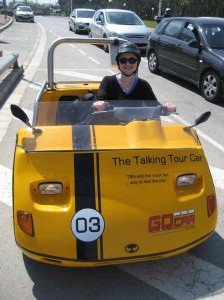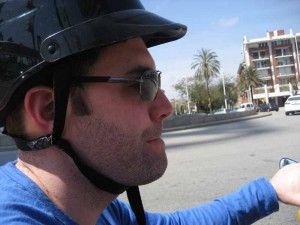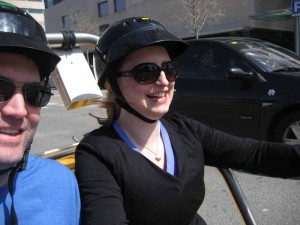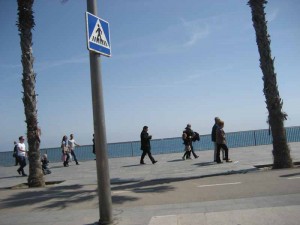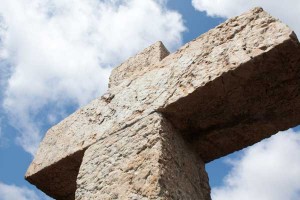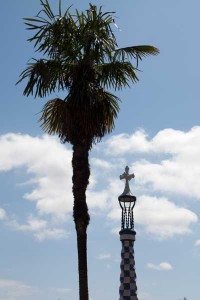Land of Peen-chos.
Deciding it was time to head out of Barcelona and make headway towards Paris, where we would be visiting our friend Matt, we planned our next destination: San Sebastian, Spain.
| From San Sebastian |
| From San Sebastian |
San Sebastian, or Donostia as it is called in Basque, is a town on the ocean in northeastern Spain, close to the border of France. It is in the heart of Basque country, which is a region spanning northern Spain and southern France, where the Basque ethnic group lives. In San Sebastian, people spoke noticeably less English than in Barcelona, with the added of challenge of frequently speaking Basque, a language with a lot of x’s and t’s, in addition to Spanish. San Sebastian is a cute little getaway where the pace was a little slower than Barcelona. It is nestled between the ocean and the mountains, with tons of shops, flowers, and quaint old architecture in between. The people in San Sebastian seemed to be very dedicated to their siesta time, even though shops and restaurants did not open early or stay open particularly late.
 |
| From San Sebastian |
The 6 hour bus ride from Barcelona to San Sebastian was pretty uneventful, save for the loud Spanish lite FM blasting from the speakers (Spanish songs frequently interspersed with Lady Gaga and Owl City’s song Fireflies) and me trying to retrieve my tres-dropped Ipod while accidentally pouring half of my water bottle on Sean’s pants as Sean and the Spanish man next to him stared in horror. (No worries, the quick dry fabric works as advertised!) We arrived in the heart of siesta time, without a reservation or a map. We eventually ran across Pension Santa Clara, one of the accommodations advertised in Lonely Planet Spain ( www.pensionsantaclara.com ). Although I was suspicious of its simple rooms, thinking it did not seem to raise the bar in our lodging as much as I would have liked, it didn’t smell like fumar (smoke) like another pension we tried (hate that fumar!), it was in the heart of the Old Vieja (Old Town), it was only 38 euros per night, and our backpacks seem to triple in weight after carrying them around town. It turns out that we loved the Pension Santa Clara. The linens were great (nice and clean and white!), the internet was super fast, and the shower in the en suite bano was full of pressure and hot. We even got to watch some TV (some gameshows in Spanish and lots of the Teledeportes channel).
| From San Sebastian |
All over San Sebastian, you will be surrounded by bars and restaurants with pinxtos (pronounced peen-chos) sitting on their counters. Similar to tapas, and essentially little appetizers that can be eaten as a snack or combined to make a meal, it was fun to try all of the different combinations.
| From San Sebastian |
One has to wonder how fresh all of these pintxos are, because save for our favorite pintxos restaurant (Casa Senra on San Francisco street in Gros), we never saw the pinxtos being replaced. No matter. The little sandwiches and seafood or jamon (ham) topped pieces of bread were so cute, it was easy to ignore the fact that seafood was sitting out unrefrigerated or that everyone’s fumar constantly wafted over the pinxtos. Plus, because there were a million different places right in walking distance, it made bar hopping very conducive. Although we stuck to the Old Vieja section the first night, we frequently found ourselves wandering about a mile down the road past the surfer’s beach to the Gros district, which is noticeably less touristy.
In San Sebastian, we quickly fell into the routine of eating pastries from the pasteleria around the corner, drinking fresh squeezed orange juice for breakfast or lunch, eating pinxtos for essentially all meals, taking walks or running by the beach, and browsing the shops. On our last day, we decided to “summit” Mount Igueldo, a small mountain overlooking the beach on one side and the town on the other, with a fort and a statute of Jesus on top. Even the cloudy, overcast day couldn’t hide the beauty and sereneness of the sight of the ocean through the trees on the mountain. The water alternates between azul and aquamarine. It has been about five years since we have visited a beach. It had been way too long, I decided.
Have you met Antonio Gaudi, Architect?
I’m not sure if Antonio Gaudi ever used his profession to get chicks like Ted Mosby (and the guy who used Ted’s likeness), but Gaudi’s buildings and creations are stunning. Gaudi is a Spanish architect who left his imprint all over Barcelona. We explored three Gaudi creations while we were in Barcelona: (1) Casa Batllo, which is a whimsical house lacking many straight lines built in 1877;
 |
| From Gaudi Architecture – Barcelona, Spain |
(2) Parc Guell, which is a public park;
| From Gaudi Architecture – Barcelona, Spain |
and (3) La Sagrada Familia, which is a cathedral designed by Gaudi, and still is not completed due to the intricacy of the design some 128 years after building began.
 |
| From Gaudi Architecture – Barcelona, Spain |
The Gaudi creations are all intricate, inspired by nature, and delightfully whimsical:
 |
| From Gaudi Architecture – Barcelona, Spain |
 |
| From Gaudi Architecture – Barcelona, Spain |
| From Gaudi Architecture – Barcelona, Spain |
 |
| From Gaudi Architecture – Barcelona, Spain |
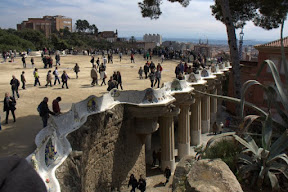 |
| From Gaudi Architecture – Barcelona, Spain |
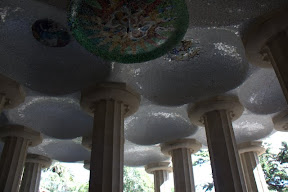 |
| From Gaudi Architecture – Barcelona, Spain |
 |
| From Gaudi Architecture – Barcelona, Spain |
 |
| From Gaudi Architecture – Barcelona, Spain |
Vroom, vroom!
Barcelona is a very compact city. It is easy to walk everywhere, and most sights were within a 10 to 20 minute walk from our hostel. Those that weren’t were easily accessible by subway or bus. We found the public transportation to be very easy to navigate, modern, and efficient (once we figured out you had to open the door to the subway train yourself). As a sidenote, why can’t Pittsburgh bus stops tell you how much longer until the bus arrives? Let’s get on that, Port Authority.
One way to see the sights in Barcelona besides walking or public transportation are the GoCars (http://www.gocartours.com/).
Completely touristy (reminiscent of the Just Ducky tours in Pittsburgh – Pittsburgh’s only tour that goes in land and water!), they also were completely fun. My friend Tim told me that he tried the GoCars in Barcelona, and he would rent one again in any city that had them. With that rousing endorsement, we had to check them out, especially once we saw they had an offer for bloggers. (Disclosure: the offer entailed us getting the GoCar free for one hour, so long as we agreed to review the GoCar on our blog, whether the review was good or bad. Even if we had paid in full for the GoCar, my review would the same).
The GoCar facility is close to the Catedral, right across from a market where we gathered ingredients for our tasty sandwich we mentioned in the last post. The car part of the GoCar name is a bit of a misnomer – they pretty much are a scooter, go-cart like contraption that travels out on the road. There is no way that something like this would be street legal in the United States, and the lawyer in me was amused that we only had to sign a brief waiver relating to damage to the vehicle, not damages to ourselves. (Our mothers should not worry – there was no damage to anything or anyone, and we wore our helmets the whole time). With some quick instructions about how to use the GoCar, we were out cruising around the streets. We quickly realized we had no idea what we were doing. Me to Sean: Huh. Wonder if we should have asked if there are any instructions for actually driving in foreign traffic. Sean to me: Yeah. That probably would have been a good idea.
Being the cheapskates frugal conservers of money that we are, particularly on this trip, we were determined to stick to our free hour. It is easy to get carried away and cruise farther than you thought, so we ended up going over (which was only 5 euros extra). If you follow the pre-planned routes, a nice British lady talks to you and tells you which way to go (perhaps related to British lady on the Tom-Tom, except the lady on the Tom-Tom gets a real attitude if you don’t listen to her. Turn around when possible. Turn around when possible. TURN AROUND WHEN POSSIBLE!). If you go off course, which we mostly did, the GoCar British lady doesn’t talk to you other than to occasionally tell you, if you turn around, you could rejoin our course, suggesting, in a polite way, that it might be nice if you weren’t so rebellious and disobedient. The GPS feature is very nice, but it is hard to hear over the engine when you are cruising down the street. Conversely, when you pull up to a light, it blares out very loudly if you had the volume up when you were driving, causing people to stare at you even more than they already were.
We were quite the site in the GoCars, admired by little kids, laughed at by adults, and generally gawked at by all others. No matter – the GoCar was fun to drive, because it essentially was like driving a go-cart, without the track. (For all of you Pittsburgh readers, it somewhat reminded me of driving the cars on the turnpike ride at Kennywood – except you were actually on a real road). Although you can cruise pretty well, we were passed frequently. Me to Sean at one point: Woo-hoo! We’re up to 40 mph. Err, I mean kilometers.
We drove down to the beach area, which allowed us to see an area of Barcelona we had not seen yet.
After a while, the GoCars get a little uncomfortable. I think they are best for a fun short ride just for kicks, like we did, or for an all day rental to see the sights, where you periodically park and get out.
All in all, the GoCars were a fun way to spend our afternoon, and a different way to experience Barcelona.
Apparently we drink wine by the bottle now.
Barcelona – from the moment we stepped off the plane, it was obvious we were not in the United States anymore. I have a feeling we may not be able to truly appreciate Barcelona for what makes it unique because we are still in wonder at the, well, Europeaness of it all. I wonder if many of the things that endlessly intrigue, amuse and/or confuddle us now will eventually become routine, pedestrian. For example: the wooden elevator that escorts us to our residencio. The large door to our building that has a smaller door subset within. The scooters speeding around all over the city. The tiny cars, including two Smart cars so small they can fit into one combined space. The sounds of people chattering about in Catalon or Spanish. The sounds of ambulancias that I previously had only heard in the movies or in films from my international terrorism class. The products in the grocery stores, which look so familiar, yet in a foreign language. Coke Lite, instead of Diet Coke. Ordering some variation of coffee, and never knowing whether it will be an espresso shot or something a tad larger (but no where near tall, vente or grande). Speculating what might be on the menu, until the waiter takes pity on you and brings you the English version of the menu (and you learn what you speculated was dead wrong). Forgetting that 5 euros really isn’t 5 bucks. Endless streets filled with quaint buildings, with flower and laundry filled terraces. A store where you can get Chanel cosmetics on the first floor, and plain groceries on the second. The negative one floor. Bottles of wine cheaper than one glass of wine at home. Lack of prominent street signs on the street itself, instead being hidden – in small print – on the buildings. People gathered around the television in bars for futbol. Prevelance of smokers, including up to date cigarette machines (unfortunately). While we do have the curious constant sensation that we are in Europe, things are still very familiar. It is probably because Barcelona is a cosmopolitan, large city, and because you can actually get the menu in English if you want.
 |
| From Barcelona |
We love walking through the curving, winding streets and alleyways, and gazing at the unique architecture.
 |
| From Barcelona |
However, without a doubt, our favorite thing about Barcelona so far is the food. (Perhaps we should have made this a food blog, and then our obsession with food would be acceptable). We have received wonderful restaurant recommendations from the owner of the hostel where we are staying. The portions are noticeably smaller here, which is good because it all is so delicious. The portion size combined with walking should keep us in check. We hope.
We read that Spanish food is very simple, and puts the focus upon quality ingredients. We would agree with that. Every day for breakfast for the last three days, I have had freshly squeezed orange juice. One of our favorite lunches has been the lunch we had today at the market, simple sandwiches consisting of jamon serrano and manchengo cheese. (Okay, it was one of our favorites until a pigeon decided to poop on Sean’s sandwich, and we had to split mine instead).
| From Barcelona |
Our dinners have been fantastic, each one better than the other. We’ve been dining the way the Spanish do, never eating before 9 or 10 p.m. So far we’ve had various tapas; ensaldas with creamy gorganzola cheese; two different dishes with sweet apples, one duck and one chicken; grilled tuna with olive oil and tomatoes; chocolate mousse with mascapone cream and crunchy tidbits; and always, a bottle or carafe of wine.
We already have had a change in our itinerary. We plan to stay in Barcelona through Monday, and are heading to San Sebastian, Spain, by bus. We’ll stay there for a few days, then we’ll be heading to Paris for about a week (squee!) to stay with our friend Matty, who is graciously letting us crash on the couch in his company-funded apartment while he is there for work. More to come about Barcelona in future posts.
